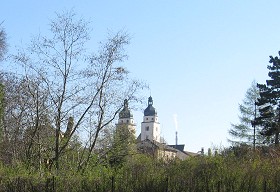


| ANNE WANNER'S Textiles in History / symposiums |
| Meeting
in Plauen, Germany 23 April to 24 April 2010 |
| Verein
Vogtländische Textilgeschichte Plauen e.V. Sitz Schaustickerei Plauener Spitze, Obstgartenweg 1, D-08523 Plauen Tel. ++ 03741/443 187 schaustickerei@web.de - www.schaustickerei-plauen.de |
 |
 |
 |
| The city of Plauen |
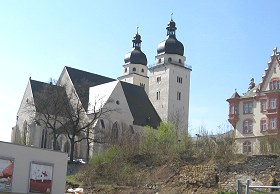 |
 |
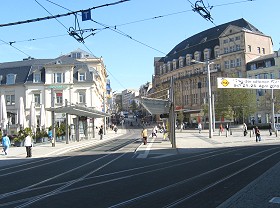 |
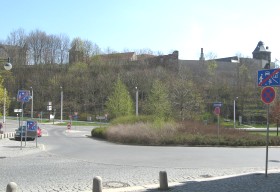 |
 |
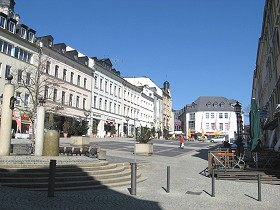 |
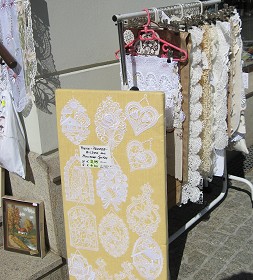 |
|
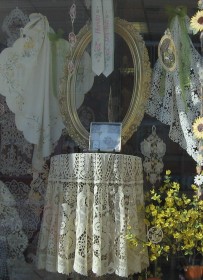 |
| Vogtlandmuseum
Plauen, Nobelstr. 9-13, D-08523 Plauen |
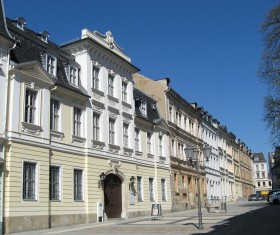 |
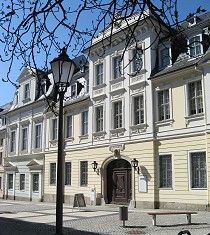 12 pm opening of the study days by Lordmayor of the city of Plauen, Ralf Oberdorfer |
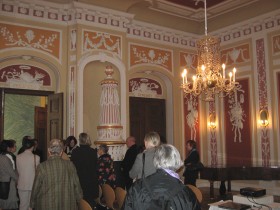 2.10 pm papers on Plauen Lace, in the festival room; by Dipl. Paed. Beate Schad, and Katrin Färber |
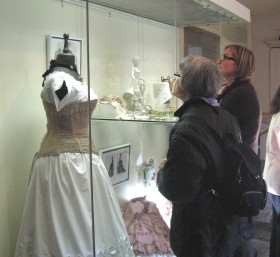 Exhibition at Vogtlandmuseum Plauen. Here hand embroidery is on show. |
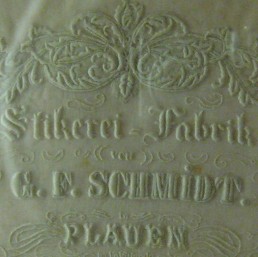 Whitework hand embroidery from 1851, exhibited at the London World Exhibition 1851 |
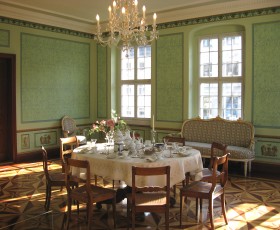 House built between 1797-99 by the cotton merchant Johann Christian Kanz. In this room the emperor Napoleon Ist spent a night in May 1812 on his journey to Russia |
| In earlier
times wollen cloth was produced in Plauen. Since the 16th
c. the production of cotton fabrics is documented and
since 1770 tambour or chainstitch embroidery was known.
It is said that Karoline Wilhelmine Krause
(married since 1802 to the cotton merchant Karl Gottlieb
Krause) learnt how to embroider the satin stitch
at the court of Weimar and introduced it around 1808/10
in Plauen Lit: Beate Schad, Plauener Spitze, filigrane Gebilde des Industriezeitalters, Plauen 2009 . |
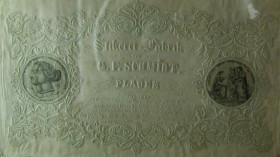 Hand embroidered presentation of the merchant Rudolf Schmidt, who lived from 1839 to 1889 at Nobelstrasse 13. He wrote memories of his youth which are presserved. |
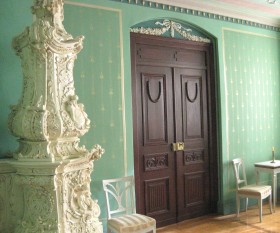 |
| The
Plauen Lace Museum Unterer Graben 1, D-08523 Plauen |
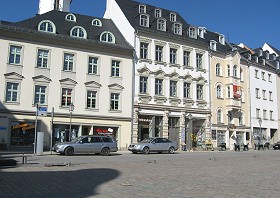 |
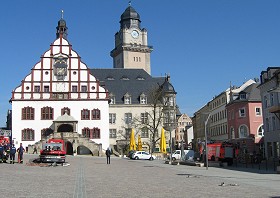 |
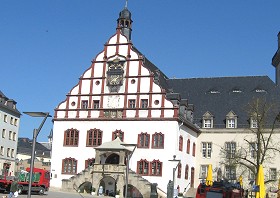 |
 |
|
|
| Fedor Schnorr (1817-1896) of Plauen discovered the embroidery machine at the world exhibition in Paris 1855. But as he did not succeed to buy this machine he sent the student Albert Voigt (1829-1895) of Chemnitz to Switzerland with the order to buy 2 machines there. | Voigt bought 2 machines in the machine factory Burkhard at St. Fiden (St.Gallen). With the technician Johann Conrad Dietrich some cases with the parts of the machines were smuggled over the lake of Constance and they arrived on 27 October 1857 in Plauen. | The machines
were set up in the factory of Fedor Schnorr and in
January 1858 the production of machine embroideries
started. Albert Voigt since 1860 developped the production and improvement of the embroidery machines. |
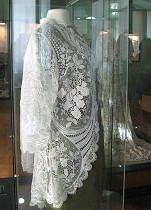 |
 |
|
| Men's coat made from assebled parts | Procedure of assembling table cloth |
| The name chemical
lace derived from the use of chlorine or caustic
soda to remove the backing. The design is embroidered with the machine and when it is finished, the background is singed away. In this way 'shaped pieces' and 'allovers' can be made. |
The
embroidery machine produces equal parts of embroidery which
have to be assebled in another working stage. On the machine parts for 28 table cloths were produced in 4794 minutes. |
The joining
of the parts took 8305 minutes. This
work was done on a sewing machine. The total working time for 28 cloths was 20752 minutes which is 12 hours and 35 minutes per one table cloth. |
| The Cornely
is a hand-operated sewing machine and it fixed a thick
thread around the outlines in patterned machine laces. The Bonnaz was a chain-stitch machine used to embroider patterns on net in imitation of tambour work. The shapes were attached by chain stitch instead of a couched cord. (Text from: A Dictionnary of Lace by Pat Earnshaw, 1982, p.106) Curtain, 1913, embroidered with the chainstitch machine on tull. |
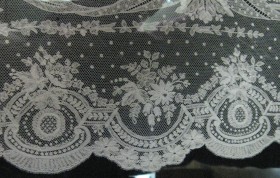 |
|
| Showing and demonstration of machine embroidery, Obstgartenweg 1, D-08529 Plauen |
 |
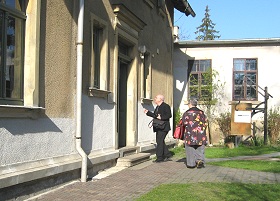 |
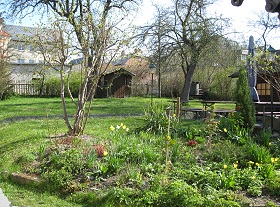 |
| The dwelling
house was built in 1889 by Max Vollstädt. In 1902 the
one-storied factory building was added. In 1904 the owner
became Albert Schiller, merchant of machinelace. The
building was used as a factory until 1997. It
was built for 10 big embroidery machines. The
measurements of the house corresponded to the size of the
machines. Rooflight and big windows gave the required
daylight. There were several changes of ownership. In December 2001 the factory became a museum to demonstrate machine embroidery. |
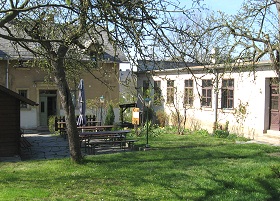 |
 |
 The genuine historic embroidery machines are completed by some machines of other Vogtland factories of the time |
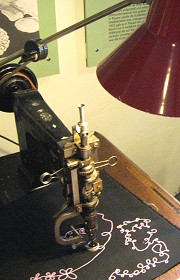 Chain Stitch machine |
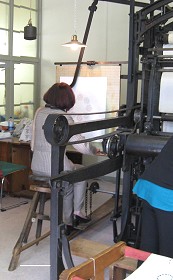 Working with the pantograph |
|
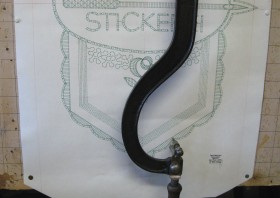 |
 |
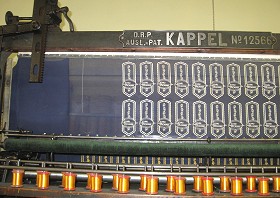 |
| The design was originally controlled by a pantograph: as the course of the threads was traced stitch by stitch on a master design. The net itself was moved and the hundreds of needles embroidered simultaneously along the whole width of the machine. | The Schiffli
is an enormous machine, often 20 yards (18m) or more
long, with the ability to reprocuce the same desing many
times over at once. It can be used to imitate the
patterns, though not the technique. |
|
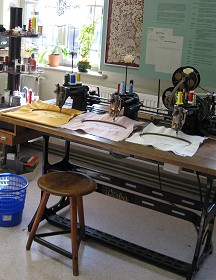 Multi-head machines |
 Threading machine Threading machine |
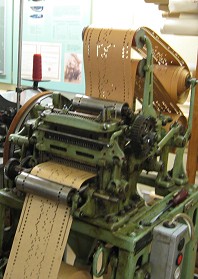 Copy machine |
|
| home content | Last revised May 10, 2010 |